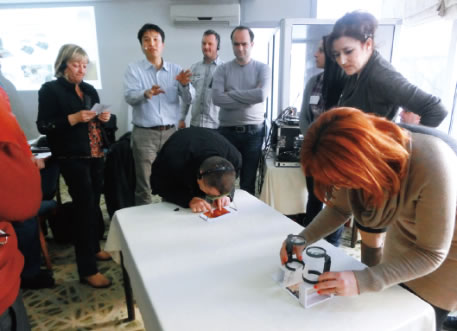Stories from the Field 08
Responding to Landslides
in Bosnia and Herzegovina
– Building mutual cooperation that transcends ethnic boundaries

Training for reading and interpreting topographic images displayed on the screen (Photo: Jun Sugawara)
Since the ethnic conflict ended in 1995, Bosnia and Herzegovina has made an effort to achieve peace under the supervision of the international community. However under the central Government there are two autonomous entities, the Federation of Bosnia and Herzegovina with large Muslim and Croat populations, and the Republika Srpska with a large Serbian population. As the two entities adopt different systems in various areas such as the economy and education, little progress has been made in terms of ethnic reconciliation.
This complex political framework also caused a delay in disaster management. In Bosnia and Herzegovina, landslides can easily occur because of various factors including geography, geology, climate, deforestation and illegal architecture on slopes. Despite these situations, no countermeasure manual has been prepared, nor have sufficient preventive measures been implemented to avoid landslides. Furthermore, the lack of cooperation between the two entities makes the disaster prevention efforts less efficient.
Under these circumstances, in May 2014, Bosnia and Herzegovina was struck by a flood due to record-breaking heavy rains. This caused more than 3,000 landslides throughout the country, resulting in the destruction of approximately 2,000 houses. To respond to the flood damage Japan provided a fund to the United Nations Development Programme (UNDP) project for Landslide Disaster Risk Management in Bosnia and Herzegovina. This project aims to prevent recurrence of landslides by taking measures in the nine affected municipalities as well as strengthening their landslide management and monitoring capacities through technical assistance.
Under this project, Mr. Jun Sugawara, a civil and geotechnical engineering expert, was dispatched to Bosnia and Herzegovina as a UNDP international consultant to assist local governments in compiling a landslide countermeasures manual and training persons in charge of landslide disaster prevention work. Working together with geological and geophysical exploration experts in the aftermath of the flooding and landslides, Mr. Sugawara engaged in on-site studies of the landslides and the ground composition.

A Japanese consultant, Mr. Jun Sugawara instructs in reading and interpreting aerial photographs. (Photo: Jun Sugawara)
Landslide countermeasures comprise two basic activities: predicting and preventing the occurrence of landslides, and responding to landslides when they actually occur. However, many of the responsible personnel at local governments and the two autonomous entities did not possess any geotechnical engineering or geology expertise. That meant that there were a small number of people who correctly understood the mechanisms of occurrence of landslides. In response, Mr. Sugawara compiled a manual featuring landslide-related information that would be immediately usable in practical situations and could be used by non-experts. The manual included information on categorization, measurement, analysis, stability calculation, and countermeasures construction work related to landslides. People working on the ground pointed out budgetary constraints as an issue, so Mr. Sugawara endeavored to ensure that his manual included methods that would be effective and also low-cost as much as possible. These included simple landslide measuring devices using low-cost construction materials, and landslide analysis using software that could be downloaded online free of charge.
In the one-week training program, Mr. Sugawara focused on fostering subjectivity among participants. The program included practical visits to actual landslide sites, where on-site surveys were conducted and simple landslide measuring devices were installed, as well as many group-learning activities, including topographic interpretation and landslide prediction. The training provided an opportunity for participants from the two autonomous entities to come together and exchange opinions, and created a system for cooperation that had not existed previously. Using the same teaching materials and manual, the participants also confirmed the role of the autonomous entities and local governments, as well as the assignment of duties.
Mr. Sugawara says, “There are natural disasters such as landslides that occur over more than one municipal jurisdiction. This training program helped to build a relationship and improve perceptions between the two entities, which will be extremely important when considering future landslide countermeasures in Bosnia and Herzegovina.”
The participants on the training program returned to their respective offices and shared the knowledge and technologies they acquired with other personnel. From now on each local government will work on responses to landslides. Mr. Sugawara has high hopes for the work of the administrative staff who took part in the training, saying, “I hope that the technology that Japan has provided will help to prevent landslides, or minimize the damage caused by them.”
This project was highly appreciated by the participating local governments and the two autonomous entities. Mr. Sugawara has since received requests from other local governments to provide the same training program.
Upon receiving these requests, Mr. Sugawara says, “Japan possesses technologies and know-how in disaster prevention and risk mitigation, based on its own experiences of frequent natural disasters like earthquakes and flooding. There are still more places, other than Bosnia and Herzegovina, where we could share the technologies and knowhow. I feel that there is great potential for Japan to make further contributions in this field.” Japan attaches great importance to mainstreaming disaster reduction and such efforts are beginning to be implemented within a framework for mutual cooperation that transcends ethnic boundaries.
<< Previous Page Next Page >>
Main Text | Statistics and Reference Materials | Stories from the Field | Master Techniques from Japan to the World | ODA Topics
